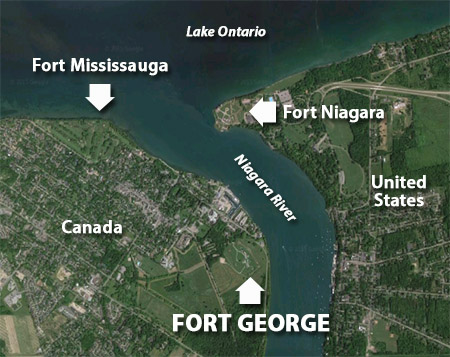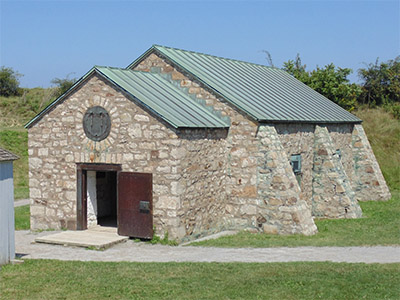 |
Fort George
Niagara-on-the-Lake, Ontario, Canada
|
|
 |
Constructed: 1796-1799
Used by: Great Britain,
USA, Canada
Conflict in which it participated: War of 1812
|
In 1781 the British government established a settlement called Butlersburg, at what is today the over-touristed town of Niagara-on-the-Lake. Most of the settlers who called Butlersburg home were American loyalists, who had been driven from their homes by those unreasonable victors of the American Revolutionary War (1775-1783). This settlement was just across the Niagara River from New York State. |
 |
 |
|
Butlersburg was incorporated as the town of Newark in 1792 and named the capital of the Province of Upper Canada, but someone eventually noticed how close this capital city was to the ever-threatening United States, so the town of York (now Toronto) was made the Province's capital in 1797.
|
Fort George's "back door" is protected by this blockhouse, triangularally surrounded with a stout fence, making it a poor man (but secure man!)'s ravelin. This blockhouse is only accessible through a stone-lined tunnel from the fort (which was added when the fort was rebuilt in the 1930's). Well, and a gate on one of the ravelin's walls, but that was locked. |
 |
The Jay Treaty (1795) was an agreement betwixt Great Britain and the United States that tied up several of the Revolutionary War's loose ends: One of these loose ends involved British troops remaining in Fort Niagara in New York State, a fortification they'd agreed to vacate in 1783 but somehow forgotten to do so. Construction on Fort George was begun shortly thereafter. This starfort was completed in 1802 and became the regional headquarters for the Centre Division British Army, which included British Regulars, local militia, freed slaves and "aboriginal warriors," which one assumes means Indians. When the War of 1812 (1812-1815) broke out, The Centre Division was commanded by Major General Sir Isaac Brock (1769-1812). |
|
|
Brock had arrived in Canada in 1804, and almost immediately caught wind of a mutiny brewing at Fort George. The British army in Canada at the time was an unsatisfied lot, and desertions to the United States were common. Many in the garrison of Fort George, however, were bent on imprisoning and/or murdering their officers and then deserting, which simply wouldn't do.
Brock arrived alone at Fort George, and single-handedly captured the mutinous ringleader, pinning him to a wall with his sabre. Twelve conspirators and seven deserters were sent to Quebec for court martial, where they testified that life under Fort George's commanding officer, Lieutenant General Sir Roger Hale Sheaffe (1763-1851), was unbearable. But, they added, if their commanding officer had been such a noble personage as Sir Isaac Brock, they never would have been driven to mutiny. Whatever, said the authorities, and all of the mutineers were executed by firing squad.
|
Sir Isaac went on to capture Detroit at the start of the War of 1812, a major victory. Though Brock was indeed a most heroic, stalwart individual, he was nonetheless killed by American sharpshooters at the Battle of Queenston Heights (October 13, 1812). He and his aide (who was probably also dead) were buried in Fort George's northernmost bastion, which was the bastion closest to the evil Americans at Fort Niagara.
The remains of Brock and his aide were moved to Brock's Monument, which overlooks Queenston Heights, in 1824. Had Brock survived, he doubtless would have single-handedly won the war, and today Canada would be an extended part of the British Empire. Oh wait, that latter part happened anyway. Thanks, Sir Isaac!
|
 |
A marker shows where Sir Isaac Brock was buried, in Fort George's northernmost bastion, from 1812 to 1824. |
|
Just after dawn on May 27, 1813, US Navy schooners commanded by Oliver Hazard Perry (1785-1819) came from the west and silenced British shore batteries, while US troops under Winfield Scott (1786-1866) landed near Fort George. Scott had to personally defend himself when a company of Glengarry Light Infantry charged the Americans as they waded ashore, but the Scottish troops were outnumbered and forced to retreat. Perry's schooners provided murderous cover fire and repulsed several counterattack attempts.
Fort George's commander, General John Vincent (1764-1848), realized that his command was going to be surrounded so ordered a hasty retreat. He ordered all of Fort George's guns to be spiked and magazines to be blown up, but so hasty was the British retreat that Americans were able to capture the fort virtually intact. One small magazine did explode, managing to dump poor Winfield Scott from his horse, breaking his collarbone in the process.
|
 The only original structure of Fort George to survive to this day is its Powder Magazine, completed in 1797. |
 |
The United States used Fort George as a base for further incursions into Canada, all of which proved unsuccessful. American forces abandoned the fort in December of 1813, whereupon it was reoccupied by the British.
Some work was done after the war to strengthen Fort George, but by the 1820's it was abandoned and falling to ruin, left in favor of fortifications further from the US border, and thus more defensible. Though the original fort had crumbled to not much, Fort George was used by the Canadian Army as a training facility through the First (1914-1918) and Second (1939-1945) World Wars, under the name of Camp Niagara. It was abandoned by the military in 1965.
|
|
|
Beginning in the 1930's, Fort George has been reconstructed to its War of 1812 appearance. The fort is now a National Historic Site, manned (and womanned) by a truly astonishing number of reenactors, and hosts an annual reenactment of the Battle of Fort George. Boy Scouts from Canada and the United States can there learn the valuable, modern skill of fighting in a 19th century infantry unit. The fort is open to visitors from April to October.
As is the case with any old edifice that was involved with death and/or suffering, many supernatural-related websites list a litany of ghostly events for which Fort George is "known." These include the inexplicable sounds of crying, moaning and footsteps, a woman in period dress who brushes her hair in front of an antique mirror through which she can enter or exit the scene, and overwhelming feelings of sorrow, nausea and terror experienced by those who enter the fort. Just the place I want to send my Boy Scout!
I would like to mention that, during my visit to Fort George in August of 2015, the only supernatural feelings I experienced were giddiness, excitement and a vast adoration of the 1797 Powder Magazine and reproduction blockhouse.
|
|
|
|
|
|
 |




